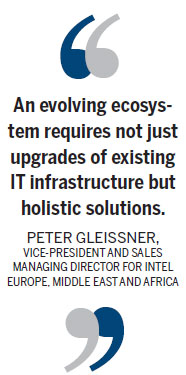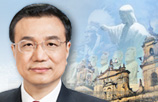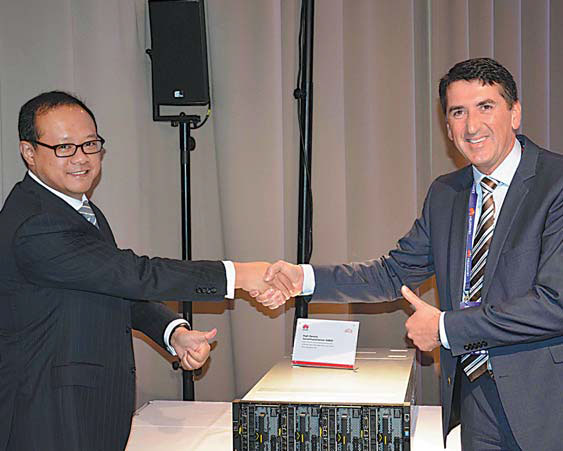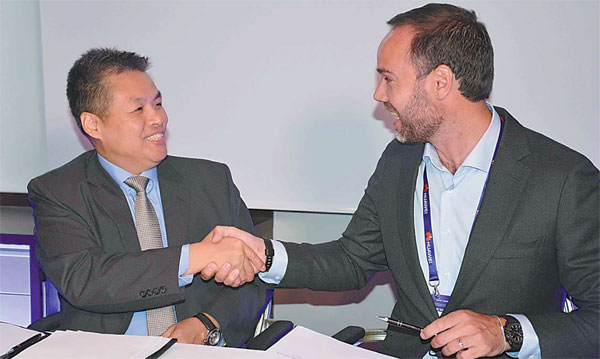Global ambitions of a technology giant
Updated: 2015-06-19 06:55
By Liu Jia(China Daily Europe)
|
|||||||||||
Chinese company aims to claim a place in pantheon of the innovators
The Chinese telecommunications company Huawei says it aims to be among the top three information and communication technology manufacturers in Europe within 10 years.
Vincent Pang, Huawei's president of its Western European region, says this goal is achievable in terms of IT hardware, software and services.
|
Vincent Pang (left), Huawei's president of Western European region and Peter Gleissner, vice-president and sales managing director at Intel EMEA, launched a new-generation server. Photos by Liu Jia / For China Daily |
|
Raymond Lau (left), president of Partners & Alliance at Huawei, signed an agreement with Jeremy van Doorn, director of EMEA SDDC Network & Security Division at WMware. |
The company also wants to help Europe achieve preeminence in telecommunications, he says.
"We are ready to work with our partners, the European Union, and everybody together," Pang says at an earlier event held before the Huawei Innovation Day.
At the event the company organized in Munich on June 15, Huawei executives and other industry leaders discussed matters such as Industry 4.0, smart cities and the Internet of Things.
Huawei wants to strengthen collaboration with its partners in Europe as they work together to advance the pace of digitization, the company says.
The Munich conference was one of three Huawei has organized in the Bavarian capital in the past 10 days. Huawei Cloud Congress Europe was held on June 10 and 11, and the Western Europe Channel Conference was held on June 11 and 12.
Huawei Cloud Congress Global, with up to 11,000 participants, is one of the world's largest information technology events. Its European offshoot and the Western Europe Channel Conference attracted 700 participants.
Huawei Technologies, founded in 1987, has been in Europe for 15 years.
"From 2004 to 2014, the number of our employees in Europe grew from less than 100 to almost 10,000," Pang says, adding that 1,200 of those work in research and development, and of those, 500 work in Munich.
The company now has annual turnover in Europe in excess of 8 billion euros ($9 billion), he says.

It has been involved in more than 200 projects in the EU and has taken part in more than 25 research projects either sponsored or hosted by the EU under the framework of Horizon 2020, the EU research and innovation program.
Huawei says it has 18 research and development centers in the continent and 31 joint innovation centers it has set up with customers and partners. The company says it spent $6.6 billion on R&D, accounting for 14.2 percent of sales revenue last year, nearly 30 percent more than the year before. Over the past 10 years, the company says, it has spent more than $30 billion on research and development.
"In terms of R&D spending in the world, we rank second among IT companies, after the US semiconductor chip maker Intel," says Gotz Philip Brasche, chief technology officer in charge of IT R&D at the Munich-based Huawei European Research Center.
Huawei and Intel are working together on innovation. On June 11 the two co-launched Huawei's new-generation server called FusionServer X6800, which uses Intel processors.
"Our customers need us to think outside the box," says Peter Gleissner, vice-president and sales managing director for Intel Europe, Middle East and Africa.
"An evolving ecosystem requires not just upgrades of existing IT infrastructure but holistic solutions."
At the Western Europe Channel Conference, Huawei signed an agreement to extend collaboration with its existing partner VMware, an IT company that specializes in cloud and virtualization.
It also announced an alliance with Commvault, a European software company and another important partner of Huawei in the domain of data protection and management.
Huawei has up to 9,400 partners worldwide, the company says, and they work closely with it in Europe. They include IT manufacturers, solutions providers and telecom operators.
"It is essential that all parties across the information and communication technology ecosystem work together," Pang says.
Huawei is intimately linked to the Global e-Sustainability Initiative, which promotes best practice for achieving integrated social and environmental sustainability through information and communication technology. It brings together 30 service providers and vendors in the sector.
In a report in June organizers of the initiative says: "As smartphones, networked sensors, smart grids and other information and communication technology devices become faster, cheaper and more available globally, the sector has the potential to deliver profound environmental, economic and social benefits."
This included a 20 percent reduction of global carbon emissions by 2030, the ability to extend e-healthcare to an additional 1.6 billion more people worldwide, and an estimated 30 percent increase in agriculture yields, the report says.
"Our findings show an information and communication technology-enabled world by 2030 that is cleaner, healthier and more prosperous with greater opportunities for individuals everywhere," says Luis Neves, chairman of GESI.
"Information and communication technology offers significant environmental benefits in addition to reducing carbon emissions."
Thanks to having information and communication technology tools as a bridge, policy or business leaders will no longer be forced to make tradeoffs between economic prosperity and environmental protection, the report says.
"An assessment of eight sectors of the global economy - energy, food, manufacturing, health, building, work/business, learning, mobility/logistics - shows that information and communication technology could generate over $11 trillion in economic benefits a year by 2030, the equivalent of China's annual GDP in 2015."
The report forecast that information and communication technology would connect 2.5 billion additional people to the knowledge economy by 2030.
For China Daily
( China Daily European Weekly 06/19/2015 page23)
Today's Top News
Visa process for Chinese traveling through Europe streamlined
Grexit risk hikes
The most costly cities for expats
China, Russia sign railway deal
No mistreatment of GSK sleuth: Govt
Lies and false hopes entrap Xinjiangers
EU seeks to ban animal cloning
HK lawmakers reject election reform proposal
Hot Topics
Lunar probe , China growth forecasts, Emission rules get tougher, China seen through 'colored lens', International board,
Editor's Picks

|

|

|

|

|

|








